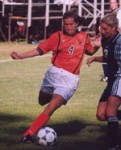
Dr. Cynthia R. LaBella, MD
Dr. Cynthia R. LaBella, MD, kicked-off the second year of the Women’s Health Research Monthly Forum, on September 22, 2009, by presenting her research on knee injuries in female adolescent athletes to an audience of over 150 professionals from the Northwestern community. Dr. Labella is the Medical Director of the Institute for Sports Medicine at Children’s Memorial Hospital and Assistant Professor of Pediatrics at Northwestern University’s Feinberg School of Medicine.
The basis for Dr. LaBella’s research is that adolescent females are the fastest growing population participating in sports, but in turn are more frequently injured compared to boys and pre-pubescent girls. The most common sites of injury for adolescent girls are the knee and ankle. In particular, girls are 4 to 6 times more likely than boys to tear the anterior cruciate ligament (ACL).
Hormonal, anatomic, and neuromuscular control differences exist between boys and girls. These differences, have been studied, to determine why girls are at a greater risk of ACL injuries. Hormonally, estrogen increases ligament laxity, yet this data has not been correlated with an increased risk of ACL injury. Anatomically, females have a wider pelvis, smaller femur notch sizes, more knocked knees (genu valgum) and more inward twisting of the thigh bones (femoral anteversion), but, like the hormone data, this also has not been correlated with an increased risk of ACL injuries.
Dr. LaBella’s research focuses on the development and evaluation of neuromuscular training tasks to prevent knee injuries in adolescent girls. Neuromuscular control is defined as muscle strength, nerve and muscle firing patterns, and the mechanics of landing and pivoting. The neuromuscular sex differences associated with the knee appear at puberty when males begin producing increased amounts of testosterone; prior to puberty neuromuscular differences are not observed. Research indicates that quadricep dominance, leg dominance, and ligament dominance are the significant differences between males and females that lead to a greater risk of ACL injuries in girls.
Dr. LaBella and her team of researchers at Children’s Memorial Hospital developed and published a neuromuscular training program that included the elements of high-intensityprogressive plyometrics, proper technique feedback to athletes, and strength training. This training program was implemented in 46 Chicago urban public high schools to study knee injuries considering the variables of race, coach compliance and injury rates. It was concluded that coaches can be trained to integrate the neuromuscular exercises into their practices. In addition, these exercises can reduce lower extremity injuries in female soccer and basketball athletes. This is a significant finding especially for populations who have limited access to medical care.
 Now that Dr. LaBella has uncovered that neuromuscular exercises can prevent knee injuries, the challenge is to disseminate her findings to more high school coaches so the information can positively impact the ever-growing population of adolescent female athletes. Dr. LaBella shared that approaching high school coaches with the notion that they will enhance the athletic performance of their athletes rather than stressing the prevention of injuries is more convincing, and leads to better coach compliance with.respect to conducting the neuromuscular exercises with their female athletes. A non-ACL injured, healthy female athlete can spend more time on the field/court practicing their skills that will only contribute to a more successful team and season.
Now that Dr. LaBella has uncovered that neuromuscular exercises can prevent knee injuries, the challenge is to disseminate her findings to more high school coaches so the information can positively impact the ever-growing population of adolescent female athletes. Dr. LaBella shared that approaching high school coaches with the notion that they will enhance the athletic performance of their athletes rather than stressing the prevention of injuries is more convincing, and leads to better coach compliance with.respect to conducting the neuromuscular exercises with their female athletes. A non-ACL injured, healthy female athlete can spend more time on the field/court practicing their skills that will only contribute to a more successful team and season.
For more information about Dr. Cynthia LaBella and the Institute for Sports Medicine, please visit, http://www.childrensmemorial.org/depts/sportsmedicine/bios.aspx.

Comments